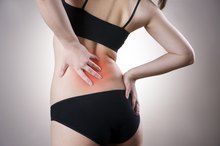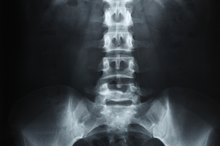Symptoms of an L5-S1 Degenerative Disc
The spine is both strong and flexible, allowing a person to move freely in many different directions. The bones of the spine -- called vertebrae -- are separated from each other by rubbery intervertebral discs that act as cushions. Over the years, the discs begin to wear out as part of the normal aging process. They become thinner and more rigid. They may also be pushed out of their usual position between adjacent vertebrae, producing a bulging or herniated disc.
The disc between the fifth lumbar vertebra and the first sacral vertebra is called the L5-S1 disc.
Because the curve of the spine changes at this location, more stress is placed on this disc than on other discs in the lower back. This makes the L5-S1 disc particularly susceptible to degeneration. Lower back pain, muscle spasms and radicular pain are among the most common symptoms of an L5-S1 degenerative disc.
Lower Back Pain
Back pain is a common symptom of an L5-S1 degenerative disc. The pain is usually located in the midline of the lower back. It is generally a chronic, mild to moderate aching sensation, with intermittent flare-ups of severe pain lasting for a few days or weeks.
Back pain from a degenerative disc is typically worse with sitting, bending, twisting, sneezing or coughing. It is often relieved with walking. Avoiding movements that cause pain and taking acetaminophen (Tylenol) or nonsteroidal anti-inflammatory medications -- such as ibuprofen (Advil, Motrin) or naproxen (Aleve) -- are often helpful.
- Back pain is a common symptom of an L5-S1 degenerative disc.
- Back pain from a degenerative disc is typically worse with sitting, bending, twisting, sneezing or coughing.
Muscle Spasms
Lower Back Arthritis Symptoms
Learn More
Muscle spasms in the lower back often occur with a degenerative disc, especially during flare-ups of disc pain. Spasm pain is typically severe. A heating pad is frequently helpful. Muscle relaxants, such as methocarbamol (Robaxin) or carisoprodol (Soma), or strong painkillers, such as opioids, are sometimes needed for a short period of time. Persistent spasms often indicate that the disc degeneration is worsening.
- Muscle spasms in the lower back often occur with a degenerative disc, especially during flare-ups of disc pain.
Radicular Pain
If the L5-S1 disc becomes very thin, bulges or herniates, nerves exiting the spinal cord can become pinched.
Pressure on these nerve roots produces radicular pain, which travels into the back of the buttocks, hips or legs. Radicular pain often feels like a shock or burning sensation.
Treating the areas of radicular pain will have no effect, as the pain originates from the nerve root.
Medications that are especially good for nerve pain, such as gabapentin (Neurontin), pregabalin (Lyrica) or amitriptyline (Elavil), are often useful.
A short course of oral steroids, such as methylprednisolone (Medrol), may be prescribed. Epidural steroid injections or spinal surgery is sometimes necessary.
- If the L5-S1 disc becomes very thin, bulges or herniates, nerves exiting the spinal cord can become pinched.
- Treating the areas of radicular pain will have no effect, as the pain originates from the nerve root.
Numbness, Tingling and Weakness
Causes of Lower Back Pain on the Right Side
Learn More
Pressure on nerve roots may produce numbness, tingling or pins and needles sensations in the areas supplied by the nerve. With an L5-S1 degenerative disc, these sensations are generally felt on the outside of the ankle, heel or foot.
Compressed nerves may also stop sending signals from the brain to the muscles they control.
With an L5-S1 degenerative disc, pressure on nerve roots can affect the muscles that bend the foot downward at the ankle. This results in weakness or complete inability to move the foot downward.
- Pressure on nerve roots may produce numbness, tingling or pins and needles sensations in the areas supplied by the nerve.
- With an L5-S1 degenerative disc, pressure on nerve roots can affect the muscles that bend the foot downward at the ankle.
Seeking Medical Attention
If your lower back pain lasts more than a few days, see your doctor to determine the cause. Obtain prompt medical care if your back pain is severe or if you develop radicular pain, numbness, tingling or weakness.
Reviewed and revised by Mary Daley, M.D.
Related Articles
References
- Merck Manual Professional Version: Nerve Root Disorders
- Spine: Surgical Outcome of Drop Foot Caused by Degenerative Lumbar Diseases
- National Institutes of Health: Low Back Pain Fact Sheet
- Medscape: Lumbar Degenerative Disk Disease
- Spine-Health: All About L5-S1 (Lumbosacral Joint)
- Spine-Health: Lumbar Degenerative Disc Disease (DDD)
- Spine-Health: Muscle Relaxants
- Ortho Secrets; David E. Brown, et al.
- American Academy of Orthopaedic Surgeons. OrthoInfo. Low back pain. Reviewed December 2013.
- Arthritis Foundation. Osteoarthritis.
- Columbia University Department of Neurological Surgery. Spondylosis.
Writer Bio
Karla Gambrill began writing health and wellness articles for LIVESTRONG.COM in 2010. She lives in central New Jersey and has worked in the health care field since 1994. Gambrill earned her Bachelor of Science in health sciences and a Master of Physical Therapy from the Philadelphia College of Pharmacy and Science.







